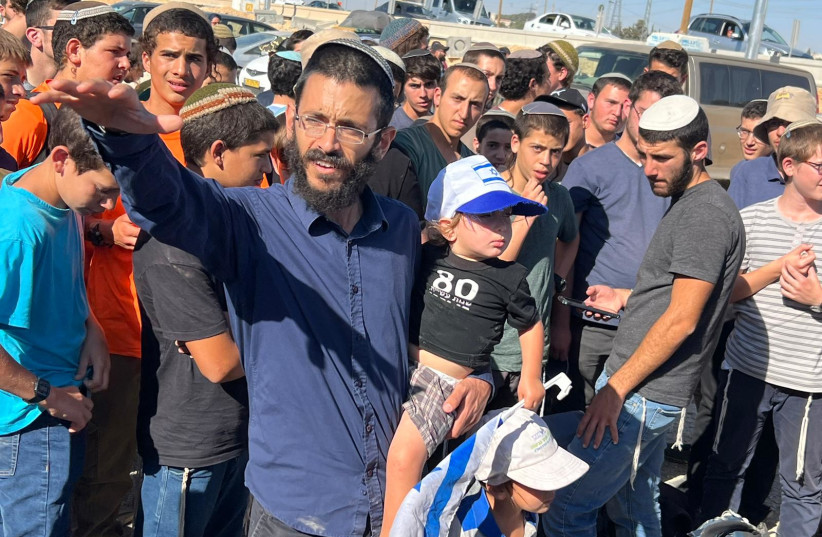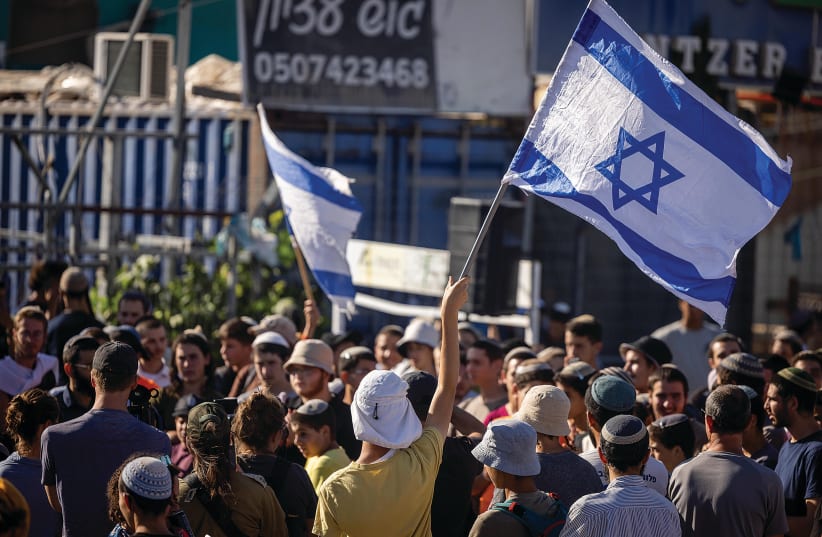Israel’s settlement leaders and activists know how to do one thing exceptionally well: set up settlements.
They know how to establish settlements without government approval, and they know how to set up settlements with government approval. They know how to do this in the middle of the night under lights provided by a humming generator, and they know how to do it in the middle of the day under the light of a blazing sun.
They have been doing it for some 55 years in all kinds of different conditions, under all kinds of different governments, and against the expressed wishes of most of the international community and a part of the Israeli public.
That they know how to do this well is evidenced by the fact that today there are some 130 settlements housing nearly a half million Jews beyond the Green Line in Judea and Samaria, not including Jerusalem.
One way not to establish settlements or settlement outposts, however, is to do what the Nahala Settlement Movement, cochaired by Daniella Weiss, the 77-year-old veteran of the 1970s storied settlement group Gush Emunim, did this week.


If you want to establish new settlements or settlement outposts, you don’t publicize the move on the airwaves and take out half-page advertisements in newspapers, as the organization did in Makor Rishon, saying, “On Wednesday, the 21st of Tamuz [20.7], we will go up en masse with settlement nuclei to a number of points with the goal of establishing new settlements throughout Eretz Yisrael.”
That’s not a serious drive to establish settlements. That’s not how it’s done, nor how it has been done successfully in the past. Rather, that is a barely hidden effort to impact the upcoming election.
If this country was not currently in the midst of an election campaign, Nahala’s action on Wednesday could be called a “protest,” and would bring to mind similar initiatives carried out in the past.
For instance, in December 1993, just three months after the signing of the Oslo I Accord on the White House lawn, a new organization called Zo Artzeinu – co-founded by a 33-year-old reserve officer in the Engineering Corps named Moshe Feiglin – launched “Operation Double.” The stated goal of this “operation” was to go to vacant hills in Judea and Samaria over a period of days and set up dozens of new settlements on land near existing ones to double the number of settlements.
Not only were these moves not approved by the government, but the initiative was not even sanctioned by the Council of Jewish Communities in Judea, Samaria and Gaza. Within two months the operation was largely forgotten. This wasn’t a real attempt at establishing facts on the ground, something the Yesha Council and its settlement arm, Amana, knew how to do very well. Rather, it was a publicity stunt to fire up opposition to the Oslo I Accord.
So, too, was the Nahala action on Wednesday largely a publicity stunt. Predictably, all seven of the new “outposts” were evacuated within 24 hours after the first tents at the sites were pitched.
Yes, as the movement’s organizers noted, this action was meant to draw attention to illegal Palestinian buildings in Area C, and the government’s acquiescence to it. But more than that, it was meant to redraw this country’s fault lines before the next election and to reestablish the settlements and the Palestinian issue as the lines that divide this nation.
Settlements, elections and the Right
SOMETHING FUNNY happened in Israel over the last three-and-a-half years, going back to the first election in the current cycle of five elections dating to April 2019: Benjamin Netanyahu became the fault line that defined this country’s rift. Love him, and you were on one side of the line; loathe him, and you were on the other.
In every election since then, Netanyahu was the defining issue of the campaign. Should he go to the Prime Minister’s Residence or prison? It remains the defining issue today as well. Not the skyrocketing cost of living, not religious-state issues, not even the settlements and the Palestinians, but, rather, Netanyahu: scoundrel or saint?
The Nahala Movement campaign, coming as it does during the election campaign, is an effort to change that, to focus the attention on the settlements, and to bring the spotlight back on the issue of a Palestinian state. Why? To fire up the right-wing base and move some of those right-wing votes currently in the anti-Netanyahu camp back over to the other side of the political divide.
Ever since new elections were called at the end of last month, reading the polls has been an exercise in frustration. The reason is that the country’s political logjam continues, with neither the pro-Netanyahu camp made up of the Likud, United Torah Judaism, Shas and the Religious Zionist Party, nor the anti-Netanyahu camp, made up of all the rest of the parties, able, at least according to the polls, to put together a strong government.
In some polls the pro-Netanyahu camp ekes out the 61 seats required to form a government; in others, it falls below that magical mark. And it all hinges on some 483,000 voters – call them the “soft Right” – who in the last elections cast their votes either for Yamina or New Hope.
Gideon Sa’ar’s New Hope Party has already merged with Benny Gantz’s Blue and White Party, leading to the question of what will happen to New Hope’s 210,000 voters. Will they gravitate with Sa’ar into the new political formation, or might Gantz be too much in the political Center for them?
And then there are the Yamina voters. Right now the party, headed by Ayelet Shaked, is not crossing the 3.25% threshold (roughly four seats) in any of the recent polls. In the most optimistic scenario, whereby she merges with New Hope refugees Yoaz Hendel and Zvi Hauser, the party may just cross the threshold, which would be the equivalent of about 152,000 votes.
But then the question will become what will be the fate of the remaining 121,000 voters. Where will they go? Will they go to Gantz’s party or perhaps to Yair Lapid’s Yesh Atid, or will they go “back home” to the Likud or the Religious Zionist Party?
These are the only voters out there who might jump not from one party to another, but from one camp to another. The fight is over them, and this explains the right-wing Nahalat Movement’s settlement outpost steps.
Ascending the hills, forcing an IDF eviction, puts this emotive issue back in the center. More than that, it will cast Gantz, who as the defense minister is the one responsible for evacuating the outposts, into the role of an anti-settler subcontractor. This will most definitely be highlighted in the coming months before the election. So what will the pro-settlement voters of New Hope do? Stay with Sa’ar even when he joins up with Gantz, or say that is one merger too far Left and jump over the fence into the other camp?
The same question will be asked of Yamina voters. Predictably, Shaked came out in favor of Nahala’s initiative, a clear indication she wants to try to hold on to those voters for whom the settlement issue has always been a top priority.
Beyond being an issue that has the potential to move voters from one bloc to the other, this is also an issue that will enthuse the base, fire people up, and perhaps move apathetic voters to come out to the polls this time.
Voter turnout in the March 2021 elections was 4.3% lower than a year earlier in the March 2020 election, and those stay-at-home voters could also have a huge impact on the results. Making the settlements the issue again, forcing clashes between IDF soldiers and border police and settler youth that will be widely filmed and circulated on social media, could motivate those who live in Judea and Samaria and their supporters inside the Green Line to vote in greater numbers than last time.
Settlements, elections and the Left
BUT THERE IS also a flip side to this coin.
The settlement issue will also fire up the Left, especially Meretz, a party whose bread-and-butter for so long has been opposition to the settlements and advocacy of a two-state solution. One reason the party is struggling is that this issue has been overshadowed by the Netanyahu issue. Bringing the settlements back front and center could have the effect of reviving that party’s sagging fortunes.
Meretz’s longtime anti-settlement and Peace Now activists MKs Mossi Raz and Gaby Lasky predictably went out to protest the protesters, and tweeted pictures of themselves in the process. Yair Golan, running for Meretz’s leadership, had this to say: “The blood of the soldiers who will die in protecting the gang of extremists on the hills will be on the hands of the criminal Daniella Weiss.”
All of a sudden, Meretz, too, found an issue – opposing, bodily if need be, the new illegal outposts – an issue that Meretz might now use to its advantage to draw voters from Labor or Yesh Atid.
But doesn’t that concern the Right? Isn’t the Nahala Movement concerned that it is playing into the hands of Meretz, which will use this issue to revitalize itself?
Not really, because if Meretz can use this issue to siphon off voters, all it will be doing is taking those voters away from other parties in the anti-Netanyahu bloc. No voters, for instance, will be moving from the Likud, Shas, UTJ or the Religious Zionist Party to Meretz because of this issue.
On the other hand, concern about settlements – their future, the outposts, whether they should be uprooted – may spur some voters in the ideologically right-wing Yamina and New Hope parties to leap over the fence to the Likud or the Religious Zionist Party in the other camp.
In what is shaping up again to be a very tight election between the two blocs, even a small move of this variety could make an enormous difference. •
